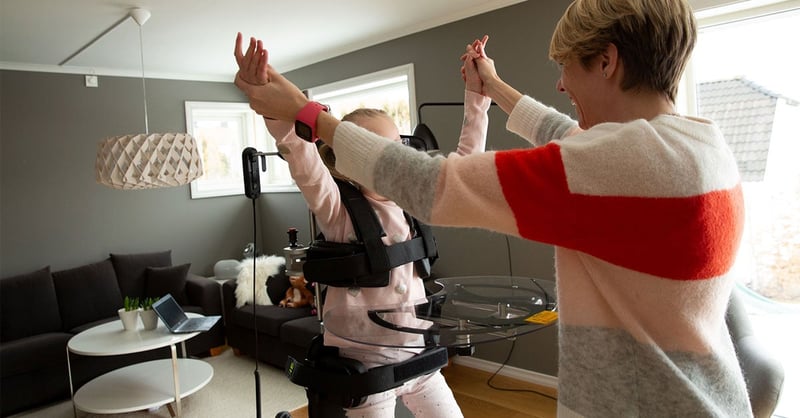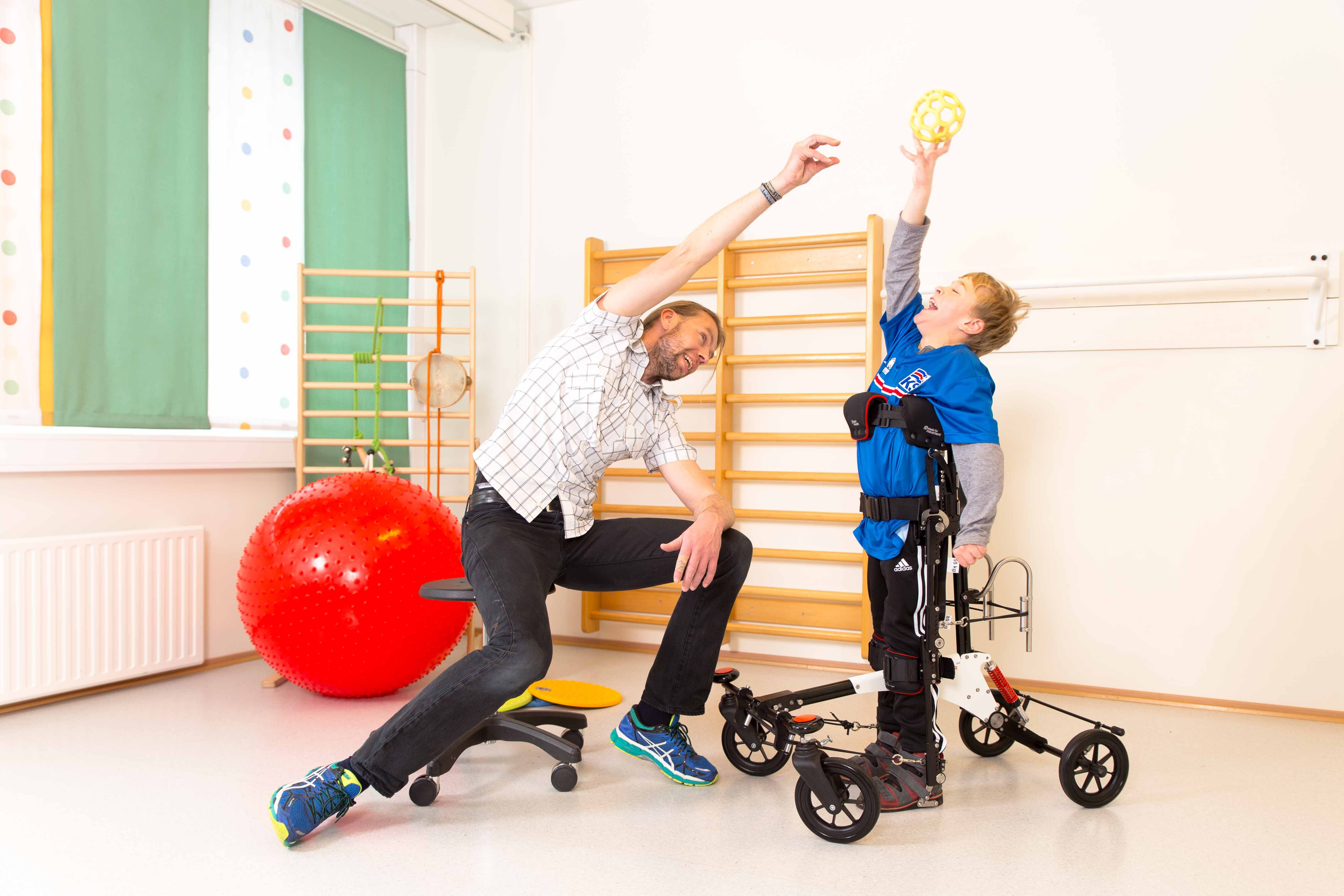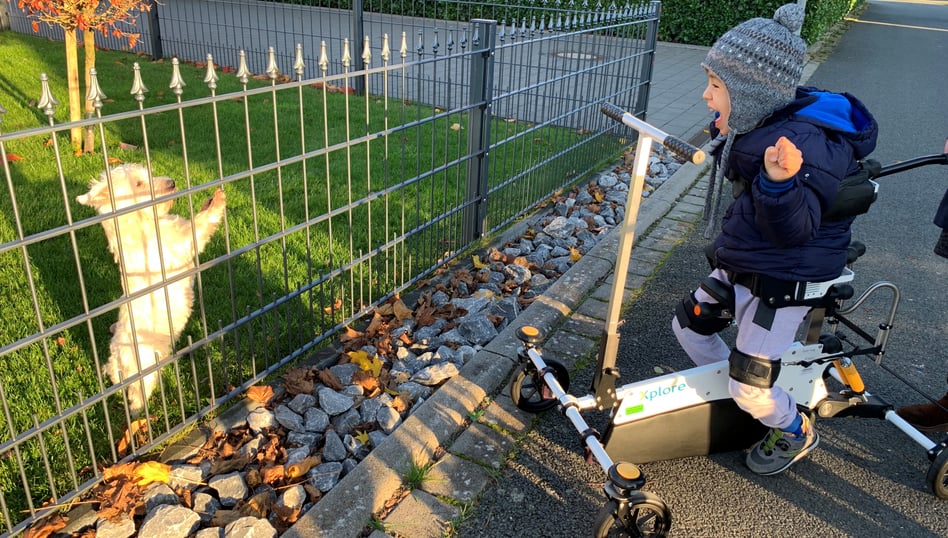Which device suits my child?


An assistive device has the purpose of supporting your child’s development, increasing independence, and letting the child explore the world despite of its disability. The Made for Movement assistive devices are designed to encourage activity and participation, but you may be asking “which of the products suits my child?”
In this article I will explain the differences and give some recommendations to help you choose.
We supply assistive technologies in two main categories.
- Walking aids designed to assist walking. They aim is to compensate for a disability by giving support to walk and allowing the child to enjoy greater freedom and independence by getting around. A walking aid is used when the child can partly support itself and have the potential to learn to walk independently or with light support. A gait trainer offers more support and is suitable when the child needs support in multiple areas.
- Assistive technologies designed to enable physical activity. They provide the opportunity for mobilisation and exercise in an upright, standing position. They accommodate complex user needs with good and safe positioning and support.
Walking aids
The Hibbot facilitates gait training by replicating physiotherapists’ hands
Children with light to moderate physical disability often experience developmental delays in gross motor skills, like reduced balance and muscle strength. The Hibbot allows for early mobilisation with high intensity gait training. It improves the ability to stand and walk by offering just enough support to balance the body and maximise activation of the lower limb muscles.
Who will benefit from using the Hibbot?
If a child can stand with some manual support at the lower trunk and pelvis, have good head control, in addition to sit independently, they can be a viable candidate. Functional level can correspond to the CP GMFCS, II-III. However, no matter the diagnose, whether it is CP, neuromuscular diseases, acquired brain injuries or syndrome pathologies, it is important to start gait training early.
The Hibbot is suitable for children from the age of 12 months up to 7 years old.
/Lauranne%20and%20Maddox%20are%20taking%20steps%20with%20the%20Hibbot%202.png?width=1200&name=Lauranne%20and%20Maddox%20are%20taking%20steps%20with%20the%20Hibbot%202.png)
The NF-Walker is a gait trainer providing hands-free social interaction for children with severe motor impairment
First and foremost, the NF-Walker enables the child to move around independently in an upright position. Being able to move around with hands free, the child can more easily participate in and perform different activities. The NF-Walker can be used already from the early age of 12 months, which gives the child a unique opportunity to explore its surroundings as it grows up. The device is mainly used by children with disabilities where independent walking or walking with light support is not achievable, for example CP, GMFCS levels IV and V.
Being in an upright position gives the child an opportunity to interact with others. It enables the user to play, participate, and communicate with peers at eye level, which can create a better sense of control, safety and connection. Having the ability to participate in social interactions can also lead to a higher sense of well-being for the child (Pin, 2007).

Why is the NF-Walker a good choice for children with severe disabilities?
The NF-Walker is unique when it comes to supporting the child. The brace system assures correction of the legs whether the child is weak, have low muscle tone or has a high degree of spasticity.
The device is individually adapted to the child and its needs. This means the NF-Walker gives a lot of support all the way from the feet to the head to encourage alignment in both standing position and while walking. You may also gradually remove support to initiate and stimulate motor development.
The Xplore is a gait trainer making long-distance walking more comfortable
Input from therapists, caregivers and parents has allowed us to develop a new gait trainer that is uncomplicated, safe, stable, and approved for outdoor use. It combines the benefits of greater flexibility, autonomy and proximity.
The Xplore allows for quick and easy set-up and adaption, and the flexible correction and support, like the seat, makes the gait trainer virtually effortless to use. It promotes independency and encourages children to explore their surroundings and participate in everyday activities.
The Xplore is designed for proximity, putting the user in centre, close to the action, while hands are free to interact with others.

Who will benefit from using the Xplore?
Most children with a functional level corresponding to the CP classification, GMFCS level III-IV, will have the opportunity to be mobile in the Xplore. The seat for self-support, combined with good upper body positioning and the dynamic frame, promotes step initiation without having to use much strength moving forward.
Assistive technologies enabling physical activity
The Innowalk provides physical and emotional well-being
The Innowalk is like a robotic cross-trainer for people with moderate to severe disabilities. The child is safely supported in an upright position with natural weight-bearing, and the device allows guided, repetitive movements of the legs with the help of a motor. In addition, handles for the arms can be added for movement of the whole body.
Being in an upright position has its benefits but adding on movement gives even more positive outcomes. It is physical activity! Physical activity boosts the metabolism and brings many health-related rewards. The Innowalk has an individually fitted support system from feet to the head, to endorse good alignment when standing in the device.

Who will benefit from using the Innowalk?
Since its launch in 2008, the Innowalk has become a valuable mobility and exercise tool for thousands of children with movement impairment. Whenever the aim is to increase the physical activity level, mobility in standing, improve range of motion in low-extremities joints and influence muscle tone among others. No ability to stand or walk is needed to use the Innowalk.
What are the main differences between a walking aid and an assistive technology enabling physical activity?
A walking aid is a device offering mobility and allowing the child to move from A to B. Walking is a complex task and the child’s strength and physical limitations will impact mobility potential. It can take time for the child to find his or her own way of walking and build enough strength to achieve it. Some children who have the potential to learn to walk should use an intensive training device such as the Hibbot. For children needing more support, the most important thing may be mobility and participation at eye level with other children. The NF-Walker is our flagship gait trainer for children with severe disabilities. The newcomer Xplore offers less leg correction but supports well the children who has places to go.
An assistive technology enabling physical activity, like the Innowalk, assists the child with movement in standing using a motor. This allows the child to experience repetitive movements, that the child might not have the capacity to achieve on its own.
For some children this might be the only way to get enough movement and physical activity during the day, whereas most of their time is spent sedentary in a wheelchair.
All our devices are developed to compensate for a movement impairment and can be used by children with light to severe disabilities already from the age of 12 months. This is the recommended age for getting into an upright position and move about.
Which product suits my child?
Children’s and families’ needs are different, and this should be taken into consideration when choosing an assistive device.
So, you should be asking yourself questions like “aim of use”, “functional level of the child”, “where to be used”, “who will be supporting the child while using the device”, “what other devices is the child using”, “What funding options are there” and so on.
Example of questions you may ask:
- What is the aim of using the device?
AIM: Walking from A to B and let the child be independent. My child has a severe disability.
SOLUTION: NF-Walker or Xplore might be the right choice.
AIM: Improve walking ability - prevent flexion in knees and toe walking.
SOLUTION: Hibbot might be the right solution to improve balance and muscle strength, preventing further development of a crouch gait.
AIM: Increasing physical activity level, as the child is severely disabled and spends most of its time in a wheelchair.
SOLUTION: Innowalk might be the right solution to increase daily physical activity level in a safe manner and with enough support to ensure proper alignment.
AIM: My child is losing its ability to walk (diagnose-related) and at risk of developing contractures in lower extremities.
SOLUTION: Innowalk might be the right solution to stimulate full range of motion in joints in a safe and comfortable way and at the same time facilitate physical activity.
Read more: Niels reduced his contractures significantly after just one year in the Innowalk.
- Where is the device to be used?
If you have very little space and limited options for walking outside with your child, the Innowalk might be the correct solution for you. Its small footprint requires little space, as it is stationary, but allows the child to move with many repetitions.
- My child likes to explore and wants to use the device in the kindergarten?
It might be that the NF-Walker or the Xplore is right for your child. Your child will have the possibility to play with peers both indoors and outdoors in the kindergarten. Both devices encourage activity with hands-free walking. You can even play with a ball while being in the device. The decision whether to choose NF-Walker or Xplore, depends on the child’s need for correction of the legs to be able to move forward. The NF-Walker brace system corrects the positioning of the legs.
Download our guide: Fun activities for children who use walkers.
So, as you can see, a walking aid and an assistive device - enabling physical activity, are two different categories of products with different aims. However, they also supplement each other, giving children the best options when it comes to activity and participation.
First published: 22.08.2019. Last updated: 26-02.2021.

Rikke Damkjær Moen brings many years of experience as clinical physiotherapist to the Made for Movement team. Her mission is to ensure that everybody, regardless of mobility problems, should be able to experience the joy and health benefits of physical activity. As our Medical Manager, Rikke is passionate about sharing knowledge so that individuals with special needs, families, and clinicians can discover the possibilities and solutions provided by Made for Movement.
A severe accident during a hockey game resulted in 35-year-old Tobias breaking his neck and becoming paralysed from the armpits down....
In this blog, we take you on a deep dive into universal design so you can understand and recognize how these principles are...
A disability entails the loss of, damage to, or deviation from bodily or psychological functions, in the form of mental, physical,...
Hear from us from time to time and learn new things
